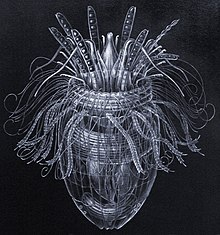Loricifera (from Latin, lorica, corselet (armour) + ferre, to bear) is a phylum of very small to microscopic marine sediment-dwelling animals with twenty-two described species, in eight genera. Aside from these described species, there are approximately 100 more that have been collected and not yet described. Their sizes range from 100 µm to ca. 1 mm. They are characterised by a protective outer case called a lorica and their habitat, which is in the spaces between marine gravel to which they attach themselves. The phylum was discovered in 1983 by Reinhardt Kristensen, in Roscoff, France. They are among the most recently discovered groups of Metazoans. They attach themselves quite firmly to the substrate, and hence remained undiscovered for so long. The first specimen was collected in the 1970s, and later described in 1983. They are found at all depths, in different sediment types, and in all latitudes.
Morphology</h2>

The animals have a head, mouth and digestive system as well as a lorica. The armor-like lorica consists of a protective external shell or case of encircling plicae. There is no circulatory system and no endocrine system. Many of the larvae are acoelomate, with some adults being pseudocoelomate, and some remaining acoelomate. Development is generally direct, though there are so called Higgins larvae, which differ from adults in several respects. The animals have two sexes as adults. Very complex and plastic life cycles of pliciloricids include also paedogenetic stages with different forms of parthenogenetic reproduction. They are not known to be present in the fossil record.
Taxonomic affinity

Morphological studies have traditionlally placed the phylum in the vinctiplicata with the Priapulida; this plus the Kinorhyncha constitutes the taxon Scalidophora. The three phyla share four characters in common â€" chitinous cuticle, rings of scalids on the introvert, flosculi, and two rings of introvert retracts. However, mounting molecular evidence indicates a closer relationship with the nematomorpha.
Evolutionary history
The loriciferans are believed to be miniaturized descendants of a larger organism perhaps resembling the Cambrian fossil Sirilorica. However, the fossil record of the microscopic non-mineralized group is (perhaps unsurprisingly) scarce, so it is difficult to trace out the phylum's evolutionary history in any detail.
In anoxic environment
Three species of Loricifera have been found in the sediments at the bottom of the L'Atalante basin in Mediterranean Sea, more than 3,000 meters down, the first multicellular organisms known to spend their entire lives in an oxygen-free environment. They are able to do this because they rely on hydrogenosomes (or similar organelles) instead of on mitochondria for energy.
The newly reported animals complete their life cycle in the total absence of light and oxygen, and they are less than a millimetre in size. They were collected from a deep basin at the bottom of the Mediterranean Sea, where they inhabit a nearly salt-saturated brine that, because of its density (> 1.2 g/cm³), does not mix with the waters above. As a consequence, this environment is completely anoxic and, due to the activity of sulfate reducers, contains sulphide at a concentration of 2.9 mM. Despite such harsh conditions, this anoxic and sulphidic environment is teeming with microbial life, both chemosynthetic prokaryotes that are primary producers, and a broad diversity of eukaryotic heterotrophs at the next trophic level.
Species
Armorloricus
- Armorloricus davidi Kristensen & Gad, 2004
- Armorloricus elegans Kristensen & Gad, 2004
- Armorloricus kristenseni Heiner, 2004
Australoricus
- Australoricus oculatus
Nanaloricus
- Nanaloricus khaitatus Todaro & Kristensen, 1998
- Nanaloricus mysticus Kristensen, 1983
Phoeniciloricus
- Phoeniciloricus simplidigitatus Gad, 2004
Pliciloricus
- Pliciloricus cavernicola
- Pliciloricus corvus Gad, 2005
- Pliciloricus dubius Higgins & Kristensen, 1986
- Pliciloricus enigmaticus Higgins & Kristensen, 1986
- Pliciloricus gracilis Higgins & Kristensen, 1986
- Pliciloricus hadalis Kristensen & Shirayama 1988
- Pliciloricus leocaudatus Heiner & Kristensen, 2005
- Pliciloricus orphanus Higgins & Kristensen, 1986
- Pliciloricus pedicularis Gad 2005
- Pliciloricus profundus Higgins & Kristensen, 1986
- Pliciloricus senicirrus Gad, 2005
- Pliciloricus shukeri Heiner & Kristensen, 2005
Rugiloricus
- Rugiloricus carolinensis Higgins & Kristensen, 1986
- Rugiloricus cauliculus Higgins & Kristensen, 1986
- Rugiloricus ornatus Higgins & Kristensen, 1986
- Rugiloricus polaris Gad and Arbizu, 2005
Titaniloricus
- Titaniloricus inexpectatovus Gad, 2005
References
This article incorporates CC-BY-2.0 text from references. Characteristics cited from: Ramel, Gordon. "The Brush Heads (Phylum Loricifera)." The Earth Life Web. Web. 03 Mar. 2011. <http://www.earthlife.net/inverts/loricifera.html>.



0 komentar :
Posting Komentar